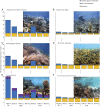Global declines in coral reef calcium carbonate production under ocean acidification and warming
- PMID: 33972407
- PMCID: PMC8166140
- DOI: 10.1073/pnas.2015265118
Global declines in coral reef calcium carbonate production under ocean acidification and warming
Abstract
Ocean warming and acidification threaten the future growth of coral reefs. This is because the calcifying coral reef taxa that construct the calcium carbonate frameworks and cement the reef together are highly sensitive to ocean warming and acidification. However, the global-scale effects of ocean warming and acidification on rates of coral reef net carbonate production remain poorly constrained despite a wealth of studies assessing their effects on the calcification of individual organisms. Here, we present global estimates of projected future changes in coral reef net carbonate production under ocean warming and acidification. We apply a meta-analysis of responses of coral reef taxa calcification and bioerosion rates to predicted changes in coral cover driven by climate change to estimate the net carbonate production rates of 183 reefs worldwide by 2050 and 2100. We forecast mean global reef net carbonate production under representative concentration pathways (RCP) 2.6, 4.5, and 8.5 will decline by 76, 149, and 156%, respectively, by 2100. While 63% of reefs are projected to continue to accrete by 2100 under RCP2.6, 94% will be eroding by 2050 under RCP8.5, and no reefs will continue to accrete at rates matching projected sea level rise under RCP4.5 or 8.5 by 2100. Projected reduced coral cover due to bleaching events predominately drives these declines rather than the direct physiological impacts of ocean warming and acidification on calcification or bioerosion. Presently degraded reefs were also more sensitive in our analysis. These findings highlight the low likelihood that the world's coral reefs will maintain their functional roles without near-term stabilization of atmospheric CO2 emissions.
Keywords: calcification; carbonate production; climate change; corals.
Copyright © 2021 the Author(s). Published by PNAS.
Conflict of interest statement
The authors declare no competing interest.
Figures




Similar articles
-
Coral adaptive capacity insufficient to halt global transition of coral reefs into net erosion under climate change.Glob Chang Biol. 2023 Jun;29(11):3010-3018. doi: 10.1111/gcb.16647. Epub 2023 Mar 21. Glob Chang Biol. 2023. PMID: 36943744
-
Reversal of ocean acidification enhances net coral reef calcification.Nature. 2016 Mar 17;531(7594):362-5. doi: 10.1038/nature17155. Epub 2016 Feb 24. Nature. 2016. PMID: 26909578
-
Declining coral calcification to enhance twenty-first-century ocean carbon uptake by gigatonnes.Proc Natl Acad Sci U S A. 2025 Jun 10;122(23):e2501562122. doi: 10.1073/pnas.2501562122. Epub 2025 Jun 2. Proc Natl Acad Sci U S A. 2025. PMID: 40455984 Free PMC article.
-
Climate change impacts on coral reefs: synergies with local effects, possibilities for acclimation, and management implications.Mar Pollut Bull. 2013 Sep 30;74(2):526-39. doi: 10.1016/j.marpolbul.2013.06.011. Epub 2013 Jun 28. Mar Pollut Bull. 2013. PMID: 23816307 Review.
-
Projecting coral reef futures under global warming and ocean acidification.Science. 2011 Jul 22;333(6041):418-22. doi: 10.1126/science.1204794. Science. 2011. PMID: 21778392 Review.
Cited by
-
Coral restoration can drive rapid increases in reef accretion potential.Sci Rep. 2025 Aug 4;15(1):28353. doi: 10.1038/s41598-025-04818-3. Sci Rep. 2025. PMID: 40759666 Free PMC article.
-
Quantifying coral reef accretion in a changing world: approaches, challenges and emerging opportunities.Camb Prism Coast Futur. 2025 Jun 27;3:e15. doi: 10.1017/cft.2025.10005. eCollection 2025. Camb Prism Coast Futur. 2025. PMID: 40881031 Free PMC article. Review.
-
Evaluation of the current understanding of the impact of climate change on coral physiology after three decades of experimental research.Commun Biol. 2022 Dec 26;5(1):1418. doi: 10.1038/s42003-022-04353-1. Commun Biol. 2022. PMID: 36572721 Free PMC article. Review.
-
Harnessing Multiscale Topographic Environmental Variables for Regional Coral Species Distribution Models.Ecol Evol. 2025 Apr 23;15(4):e71292. doi: 10.1002/ece3.71292. eCollection 2025 Apr. Ecol Evol. 2025. PMID: 40270802 Free PMC article.
-
Emerging skeletal growth responses of Siderastrea siderea corals to multidecadal anthropogenic impacts in Martinique, Caribbean Sea.Sci Rep. 2025 Jul 2;15(1):23127. doi: 10.1038/s41598-025-08709-5. Sci Rep. 2025. PMID: 40604069 Free PMC article.
References
-
- Stuart-Smith R. D., Brown C. J., Ceccarelli D. M., Edgar G. J., Ecosystem restructuring along the Great Barrier Reef following mass coral bleaching. Nature 560, 92–96 (2018). - PubMed
-
- Hughes T. P., et al. ., Coral reefs in the anthropocene. Nature 546, 82–90 (2017). - PubMed
-
- Deloitte Access Economics , Economic Contribution of the Great Barrier Reef (Deloitte Access Economics, 2013).
-
- Costanza R., et al. ., The value of the world’s ecosystem services and natural capital. Nature 387, 253–260 (1997).
-
- Perry C. T., et al. ., Loss of coral reef growth capacity to track future increases in sea level. Nature 558, 396–400 (2018). - PubMed
Publication types
MeSH terms
Substances
LinkOut - more resources
Full Text Sources
Other Literature Sources
Medical

